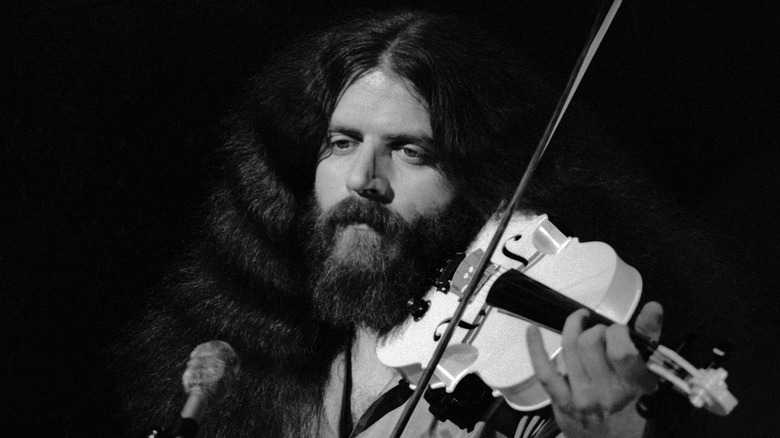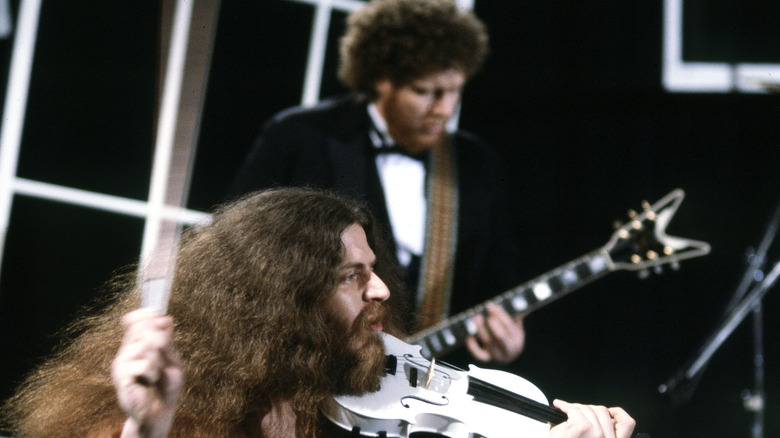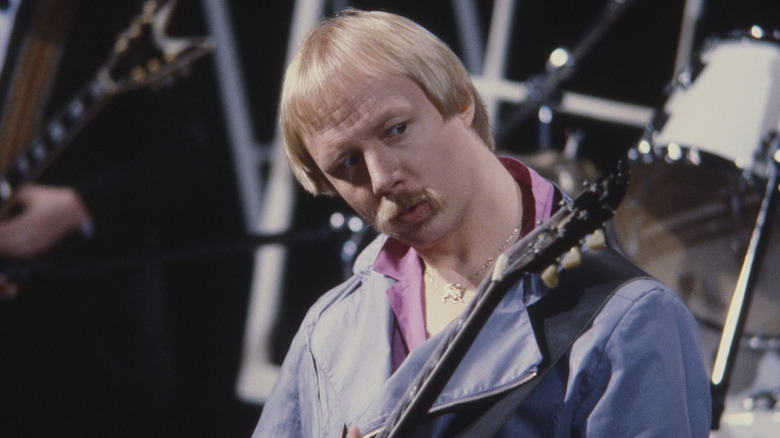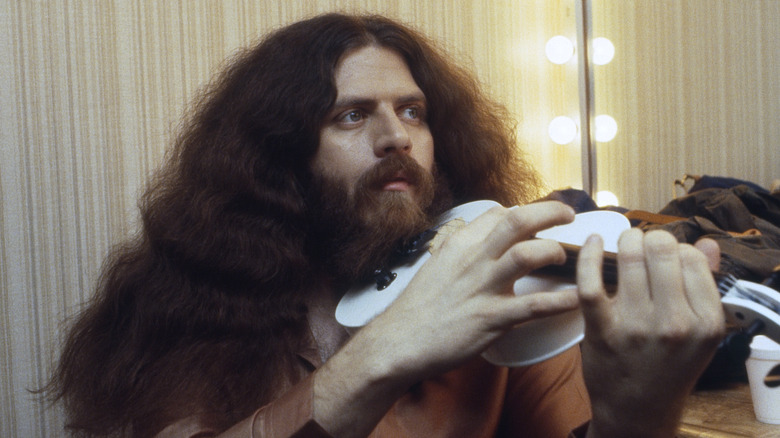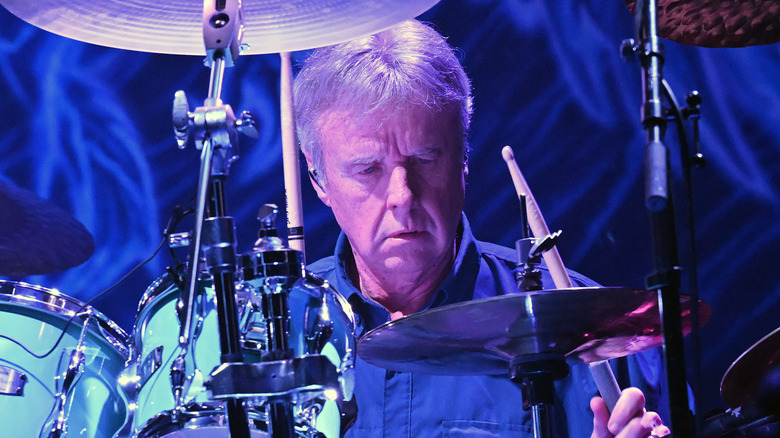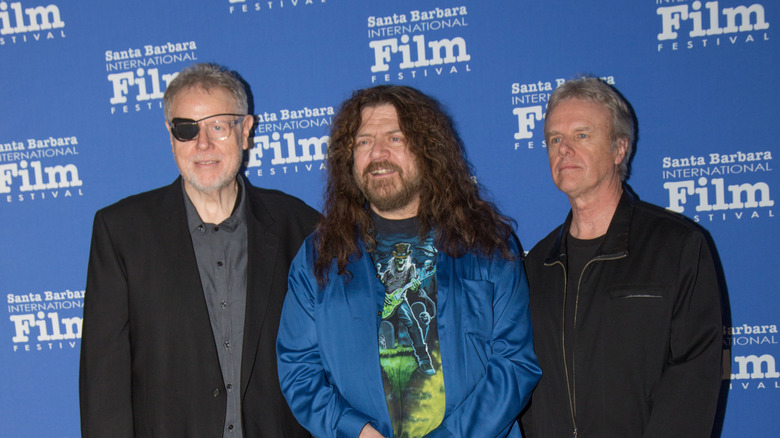The Tragedy Of The Band Kansas Explained
Kansas occupies a unique spot in rock music history, forming and thriving after the freewheeling progressive and psychedelic rock of the 1960s gave way to introspective and folky singer-songwriters, as well as the bombastic, fist-pumping, lighter-hoisting world of arena rock of the 1970s. The band, which really did come together in the state of Kansas, bore the traces of all those genres and more. A definitive act of the classic rock era, Kansas combined guitar shredding and keyboard riffs with thoughtful and even spiritual lyrics, as well as quirky instrumentation. As a result, it sold millions of albums on the strength of memorable anthems like "Dust in the Wind," "Point of Know Return," "Hold On," "People of the South Wind," and "Carry On Wayward Son."
But through all the joy in the music, there's a palpable bittersweet undercurrent. The members of Kansas experienced a lot of pain and sadness, together and apart, and across their professional and personal lives. Many fans may not even know that Kansas has experienced a multitude of tragic events across its 50-plus years.
The reason why Richard Williams wears an eyepatch
Kansas formed in the early 1970s, and as of 2025, the only founding member still playing with the band is its guitarist, Richard Williams, recognisable for the eyepatch he wears during live performances and in music videos. That's a choice that's purely functional, as Williams happens to be one of the few rock stars missing a body part. Around the time of the Fourth of July, in the summer before eighth grade, Williams had set off all the fireworks he'd purchased, got bored, bought some more, and got to work. "I went down to my basement and dumped all the powder from the firecrackers into a glass medicine bottle with a porcelain top with the intention of making a bomb that would make more of a statement than simply blowing up a bunch of firecrackers," Williams explained to Guitar World.
As Williams attempted to seal the top of the device, the rubbing started a fire, and his homemade fireworks bomb blew up in his hands. Taken quickly to a hospital by his parents, doctors weren't able to save or reattach Williams' eye in the wake of the damage. "I wore a prosthetic eye for a while, but I got rid of it because it wasn't very comfortable," he said, explaining the use of the patch to conceal the site of the injury.
The music industry didn't want Kansas
When Kansas emerged in the early 1970s, it didn't sound much like any other band on the radio at the time, owing in large part to songwriter Kerry Livgren's searching and complex lyrics and the extensive use of violin, a nontraditional rock instrument. Kansas' sound was so new that it was untested, and record labels stayed away. Grunt Records, an RCA division created in 1971 by the psychedelic rock band Jefferson Airplane, passed after some early talks before Kirshner Records, operated by Don Kirshner – a prominent figure in the history of the Monkees – signed the group.
The 1970s music industry was a messed-up place, and Kirshner was in no rush to break Kansas. The group took a while to record the first, self-titled Kansas album, but Kirshner Records shelved it for seven months. It ultimately sold 100,000 copies, thanks almost entirely to the promotion Kansas received as the opening act for touring mid-tier rock band Mott the Hoople. Over the next several years, Kansas kept playing shows as a support band and recorded more LPs. Finally, album No. 4, "Leftoverture," sold 4 million copies thanks to the single "Carry On Wayward Son." While Kansas was finally popular, its members didn't see much financial enrichment; most of the money generated was used to pay off the debt owed to Kirshner Records incurred by half a decade's worth of production and studio costs.
Substance misuse was a major factor in Kansas breaking up
The one thing Kansas had that none of its arena rock cohorts in the 1970s could touch was the haunting, virtuosic violin work of founding member Robby Steinhardt. His contributions were so intrinsic to Kansas that when he departed the band in 1982, the group's creative and commercial golden age came to an end soon thereafter.
Steinhardt would return to Kansas in the 1990s for another decade and a half before his permanent exit. The reason he had to go the first time around was due to some personal problems. "I had some health issues which is really why I left the group," he told Growing Bolder in 2021. "It gave me the chance to do some thinking and writing." More specifically, those medical issues were related to substance misuse. That, in turn, sped up Kansas's split. "The violin was gone," songwriter and guitarist Kerry Livgren told Classic Rock. "I wasn't even sure what Kansas was any more."
Substance misuse also played into why bassist Dave Hope had to leave Kansas in the 1980s. During the previous decade of Kansas's rise, no one in the band misused drugs more than Hope did. After a religious conversion helped him find sobriety, he realized that being in Kansas provided too many temptations. "People were still offering me drugs, and girls were asking where the party was," he said. "I couldn't be an alcoholic and work in a liquor store."
If you or anyone you know needs help with addiction issues, help is available. Visit the Substance Abuse and Mental Health Services Administration website or contact SAMHSA's National Helpline at 1-800-662-HELP (4357).
Kerry Livgren nearly died in 2009
Kerry Livgren has been Kansas's guitarist, keyboardist, and main songwriter for much of the band's five-decade existence. A huge musical star who switched genres, Livgren departed Kansas for a while to form the Christian rock band AD in the 1980s, then moved back to Topeka, Kansas, in the 1990s to open a production company and recording complex help him finish his lifelong passion project, "Cantata: The Resurrection Lazarus."
It was during this period in September 2009 when Lazarus had a stroke, about two weeks shy of his 60th birthday. While the musician's relatives assured the public that Livgren was alright, it took him a long time to recover and regain the basic functions that the stroke had affected. "I couldn't even give music any serious thought," he told Goldmine Magazine. "I was much more concerned with things like walking and talking." By 2014, Livgren was able to speak and record music, but he hadn't entirely put the stroke behind him. "My recovery was miraculous in that I lived, but I'm afraid that now I have hit a plateau. I still have hope."
Steve Walsh left Kansas twice
While Kerry Livgren was the main creative force in Kansas, Steve Walsh was the voice of the band. Walsh also wrote many songs, but nothing that reached the popularity of Livgren's. Inside of Kansas, the 1976 multi-platinum LP "Leftoverture" was seen as a Livgren-driven project, much to Walsh's chagrin. "Suddenly we were caught up in the excitement of starting to make money. I was still so naive, it didn't even occur to me that Steve might resent success for an album he hadn't written anything for," Livgren told Classic Rock. During production on the 1977 album "Point of Know Return," Walsh announced he wanted to go solo, but the other members of Kansas talked him out of it for a while, although he finally did leave in the early 1980s to start the band Streets.
He came back in 1986, but left permanently in 2014. This time, it wasn't because he wanted to sing more somewhere else, but because he had trouble singing at all. With vocal issues impossible to ignore, he exited Kansas. "Let me just say that it's time for me to go, and yes, it makes me sad to have to admit that," Walsh wrote on Facebook (via Melodic Rock). "Steve had been struggling for years with his voice, but besides that, he just wasn't enjoying it any more," Kansas member Richard Williams explained to Prog.
Kansas's violinist Robby Steinhardt died
Kansas's original violin player, Robby Steinhardt, performed with the band through its entire first decade, leaving in 1982 for health reasons and returning to the group in 1997 for a nine-year stint. In the 2010s, Steinhardt had a serious medical crisis in the form of a heart attack. The cardiac episode was of such severity that the violinist was kept under medical supervision for 53 days. "It took me 63 years to realize that you just can't live life like you did when you were 18," Steinhardt told Growing Bolder. "I am the happiest I have been in memory, I have love, great friends and a great album on the way. What could be better?"
After emerging from one health scare, Steinhardt didn't survive another. In July 2021, Steinhardt had just finished recording the very first solo record in his very long and storied career, and he was planning a comeback tour to promote it. None of that would come to pass, as Steinhardt contracted pancreatitis, a painful inflammation of the pancreas. The effects of the disease killed the musician; Steinhardt died in a hospital in Tampa, Florida, at age 71.
Steve Morse walked away from music for tragic reasons
Journeyman guitarist Steve Morse has made a career out of filling empty spots in the rosters of some of the most enduring rock bands. In addition to fronting the Steve Morse Band, he played with Deep Purple for nearly 30 years from the mid-'90s onward. Prior to that gig, he joined the reunited Kansas, and his playing is all over the band's late 1980s albums "Power" and "In the Spirit of Things."
In 2022, Morse necessarily had to quit any and all bands because of the health of his spouse. At first, Morse said that he was stepping away from Deep Purple on a temporary basis to help provide care for his wife, Janine, who had just been diagnosed with cancer. Three months later, he retired to provide full-time support. "We are learning to accept stage four aggressive cancer and chemo treatment for the rest of her life," Morse told Classic Rock. "I'll miss everybody in the band and crew but being Janine's helper and advocate has made a real difference at many key points."
In February 2024, Janine Morse died. "We had been in a period of remission which lasted not nearly long enough," Steve Morse said on social media channels (via Blabbermouth). The last concert the couple attended together — one of their final outings — had been a Kansas show in Florida.
Former Kansas member David Ragsdale was robbed
The classical, heart-tugging strains that can only be made with a violin are integral to the music of Kansas, and it takes a special player and special equipment to make it all happen. Filling the void left by original band member Robby Steinhardt, violinist David Ragsdale became a part of Kansas in 1991, performing live and on record with the group until 1996, only to return in 2006 and stay until 2023, when he decided to quit "to focus on personal matters," according to the official Kansas website.
During his first era in Kansas, Ragsdale was the victim of a potentially catastrophic theft. He had been loaned an innovative, state-of-the-art electrified violin made out of a graphite composite, and he left it in his dressing room at the Showcase Concert Hall in Raleigh, North Carolina, when Kansas was booked to play a concert there in September 1991. Two men were seen loitering in the area, but venue staff thought they were part of Kansas's entourage. They weren't, and they were the suspected culprits after Ragsdale's $3,600 violin disappeared. "The sound and feel of the instrument was a revelation to me, with rich presence and flawless intonation," Ragsdale told the Associated Press. "Now I feel lost without it."
Kansas drummer Phil Ehart had to retire for health reasons
The career of Kansas is effectively also the career of Phil Ehart. The group's very first drummer from the outset in the early 1970s, he took on the job of band manager in the mid-1980s. One of the only remaining original members of Kansas, Ehart played on and/or helped produce every Kansas studio album while consistently sitting behind the drum kit in concert, barring extenuating circumstances. When he became too sick to play for a period in 2016, Ehart's drum tech Eric Holmquist performed in his stead. Following a prolonged term in Kansas's 50th anniversary tour in 2023 and 2024, Ehart couldn't play the drums because of the need to rehabilitate his arms. Holmquist subbed in then, too.
In 2024, Ehart was forced to take an indefinite leave of absence from Kansas after facing his most serious health issue to date. In February of that year, the drummer had a heart attack, and it wasn't safe or healthy for him to hit the road for Kansas concerts anymore.
Kansas singer Ronnie Platt has cancer
Ronnie Platt had a difficult task in front of him in 2014, when he joined Kansas, replacing the band's longtime signature vocalist Steve Walsh. As Platt recalled to "The Rock Brigade" (via Ultimate Classic Rock), dark thoughts swirled while still hypothesizing about taking the gig: "What have I gotten myself into? Am I going to go out, taking Steve Walsh's place, and they're going to stone me until there's nothing but a pile of bloody apple sauce in the middle of the stage?" Platt had worked as a truck driver for 25 years before he took on singing duties in the band Shooting Star just seven years earlier.
Platt's tenure in Kansas didn't turn out to be as dramatic as he feared, but he still faced a frightening health issue. In February 2025, doctors diagnosed Platt with cancer of the thyroid gland. "Before everyone gets all excited, it has a 99% survival rate, it has not spread," he wrote on Facebook. "This is just a bump in the road." Kansas necessarily had to call off some concert dates while Platt could receive medical attention. A month after the announcement, and after recovering from a cancer surgery, he was ready to take the stage again.
The band maintained a connection to a seriously injured fan
In August 1978, 14-year-old John Hoffert attended a Kansas show in El Paso, Texas. On the drive back home, the vehicle Hoffert was riding in was involved in a violent collision, and the hood of the car struck Hoffert in the face. He sustained a broken jaw and nose and a completely destroyed left eye. Hoffert was also in a coma for most of two months, and he was left permanently blind. When the members of Kansas received word that one of its fans had been hurt following their tour stop, they reached out to Hoffert's family and offered to pay a visit. The teenager's father passed, on account of how his son was unconscious.
Kansas was persistent. In 1979, when Kansas returned to El Paso, it sent a limousine to take Hoffert to its show and a backstage meeting. Kansas had also dedicated its 1978 live album "Two for the Show" to Hoffert. "Being that Kansas was the last visual experience that John will ever have — we dedicate this album to him," the LP cover read (via the Fremont News Messenger). The band gave him the platinum album plaque that "Two for the Show" earned, with a dedication written in Braille. Ever since, drummer Phil Ehart and Hoffert have stayed close. "We just bonded as buddies. To this day, we get together on the phone, and he comes to see us at concerts," Ehart said in 2016.


